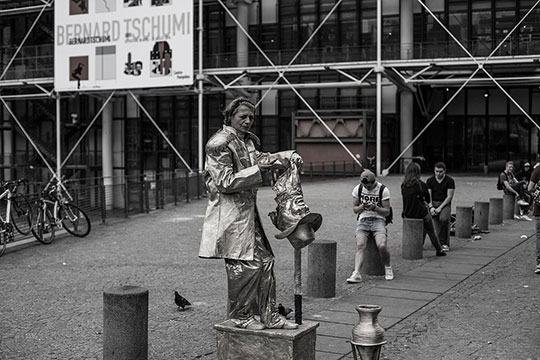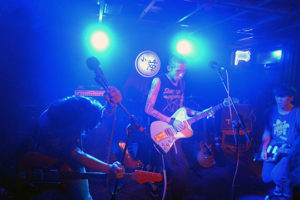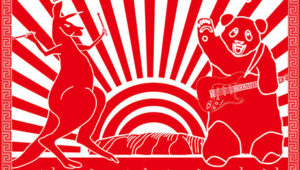
Originally published on Genjing Records
Let’s cut to the chase here, Beijing duo, After Argument’s This Is Not Your Game is a whopper of an LP. As stated before, we don’t have favorites from our catalog, per say, but this one most certainly gets a lot of spins around the office and for good reason. It’s badass, repetitious (in a good way) faultless post-punk experimentalism. Perhaps we’re a smidge bias, but it honestly might well be one of the best guitar/drums records to make it’s way out of the PRC. Part of the allure of the album is the provocative image which adorns its cover: a photo of a (presumably) insecure child hiding behind a curtain door. It’s a photograph one can’t help but study over and over whilst the 12” does its 33RPM thing atop a turntable.
The photographer who took the shot was none other than Brazilian, Tanara Stuermer, an art history graduate who focused on the arrival of photography in Brazil in 19th century during her school days. Post university, Tanara began to roam the streets and alleyways of New York, then cities around Europe, documenting the world in her own way. From her black and white photos, you can feel a sense of inexplicable melancholy hiding beneath the surface of her subject matter. It’s a feeling that is not obvious but is always present. An overt study in subtlety, if you will.
Recently, we had a chance to speak with Tanara about all manner of stuff, including, naturally the After Argument album which drew her to our attention.
Last time we spoke, you told me that you studied semiotics and philosophy in order to write your graduation thesis as an art history major and it has influenced your photos (dramatically) ever since. I noticed that people in quite a few photos of yours only present their back, revealing an atypical side of themselves, photogenically. Could you elaborate on why you choose to frame your subjects in such a light, er, philosophically?
Actually, I don’t think I really refer to semiotics and philosophy while taking pictures – only when I write about other people’s work on photography. My own approach is more spontaneous and less theoretical. Quite simple and modest.
Your comment regarding my photos where people reveal only their back, not their faces, is very perceptive, but the answer is a simple one: I also take photos of people’s faces, but I resist showing those photos unless I get authorization from the people portrayed to use their frontal image.
Following the previous question, I couldn’t help but notice almost all of your photos are black and white. Is that simply an aesthetic preference or is there something deeper you’re trying to capture?
Purely aesthetic. I think black and white photos look good. Sometimes the combination of certain colors can be annoying to me. But I’m trying to change that.
In the photos that you took in Rio de Janeiro, the subjects appear to be local manual workers. What was their story? I’m also quite confused as to why you stuck to the black and white format even when you were at the beach, a place of color and energy?
Sometimes I go to places like street fairs and local communities (repeatedly) until I get used to the environment. I typically ask for permission to just stay there and photograph after a while. There is not always a specific story to be told.
As to your question regarding the beach photos, I am afraid I am not a typical landscape photographer. When I am on the beach, or just passing by at the seafront, my interest is not in showing the place in all its color. I rather try to find discrete scenes of melancholy or other emotions that are not obvious but are always present even in a colorful and energetic environment.
Do you feel like your experience as a street photographer at The Guardian changed or influenced your photography in any way?
I always liked to document things, so street photography came naturally to me. One of the main reasons why I enrolled in this course offered by the Guardian newspaper in London in 2012 was to have classes with Matt Stuart, a British street photographer that I admire, and Stephen McLaren, who by the way, has a very interesting series of pictures taken in Beijing. We had a workshop during a weekend where they gave great tips and “rules” about photographing people outside.
After you completed the course at The Guardian, it seems the streets and alleys of mainland Europe became your playground. Tell us what is it like to roam around the continent and view European life through your lens?
I prefer to photograph in more urban environments, which is not really the case in Rio de Janeiro, where I live. This is why I usually take the opportunity when I happen to be travelling around Europe or New York City to take out my camera and stroll around to photograph. I also feel more free in most European cities. People seem to care less that you are there taking pictures. In Rio de Janeiro, in contrast, people sometimes stop to chat and ask me about which newspaper will publish their picture, and then I have to explain what I am doing, and it kills most of the spontaneity.
Windows of all kinds with people or sculptures leaning against them seem to appear in your photos either as symbols or ways to construct a specific perspective. What can you tell us about this inclination of yours?
I always liked windows. I know it sounds like a cliche, but I think photography is really like a window that I choose to open through a certain frame. The important aspects of any image are not only what is inside of the frame, but also what is left out. It leads you to an interpretation.
As for sculptures and monuments, I think they are very melancholic. Those that I choose to photograph are very beautiful (in my eyes), but they seem to be forgotten memories that were left behind and do not belong to our time, yet at the same time are still here, frozen, and you have to do something about it. I think I try to invoke this kind of reflexion in my pictures.
You participated in two collective exhibitions in New York City in 2013. Could you tell us all about the exhibition? What were the themes of these exhibitions? Of all the exhibited photos of yours, which was the one that represented your style most perfectly?
The first collective exhibition in New York City had a very broad theme – “The Story of the Creative” – and was aimed at displaying new photographers with different styles and backgrounds from around the world. The second exhibition was similar, but as an unexpected bonus – the best pictures were displayed on a big screen at Times Square.
Among my photos that were exhibited in those occasions, my personal favorite is the one with the dog on the street, which I took in Berlin in 2013.
Not long after the exhibition, Yang Haisong approached you for your permission to use one of your photos as the cover of After Argument’s newest LP. Where and when did you take the photo? What are your specific thoughts on this photo? Did Haisong give you any feedback you’d like to share?
I took it in early 2013 in a neighborhood in Rio de Janeiro called Tavares Bastos.
My husband Marcos was in contact with Yang Haisong at the time researching about the indie music scene in Beijing. Marcos mentioned I was a photographer in Brazil, and Yang Haisong was interested in seeing my work. After visiting my website, he asked permission to use that specific photo for the cover of After Argument’s new album. He said he found it “very beautiful”. I was extremely excited that he asked and, of course, I said yes immediately!
What is your favorite photography gear, that you own? Feel free to get geeky.
I’m sorry to disappoint you, but I don’t really have a lot of gear. I use a Canon 5D Mark III and a 1.4 35mm lens (I adore my 50mm, as well). No tripods, no filters, not a lot of gadgets. The only thing I always have with me is a plastic bag because you never know when it’s going to rain.
What kind of professional tools do you use to process the post-production?
Adobe Lightroom is a good tool to correct light and colour. But I use it very moderately. I mean, if the picture is not good, there’s nothing you can do about it. The process of rejection of an image is important too. I never ever used Photoshop, but would like too one day, out of curiosity.
Do you have some idols in the field or photographers admire? Do they influence you in any way?
I admire a lot of photographers: Henry Cartier-Bresson is an obvious one. I cherish the humor of Elliot Erwitt. I highly value the work of Mary Ellen Mark, Laszlo Moholy-Nagy, Mario Cravo Neto, Saul Leiter, Miguel Rio Branco, Harry Gruyaert, André Kertész, Garry Winogrand…All of them influenced me in different ways.
Last year you were commissioned by a start-up art gallery to write about photography. Could you tell us about the gallery and the work you’ve done for them?
They called me to produce content for the gallery, but I ended up developing their concept as well. Although I’ve already concluded my part, the gallery is still a work in progress.
If you enjoyed these photos check out more of Tanara Stuemer’s work on her website and grab your own copy of After Argument’s This Is Not Your Game, with her stunning cover photo, from our shop.














